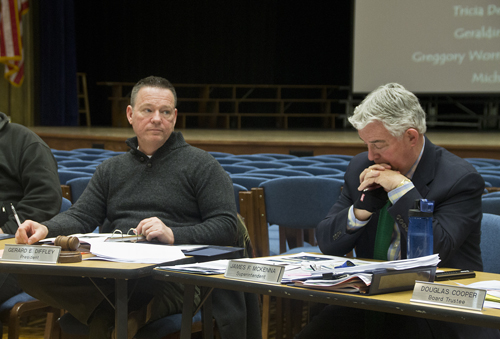With enrollment shrinking, Mattituck-Cutchogue must close wider budget gap

The budget gap at Mattituck-Cutchogue school district has grown to an estimated $200,000 for the 2014-15 school year thanks to BOCES costs, repairs to tennis courts and software licensing, Superintendent James McKenna said at a sparsely attended budget workshop Thursday evening.
District officials said they hope a recalculated state aid formula will deliver enough funds to close the gap; the district has prepared some possible cuts to non-curriculum budget items to close the gap should state aid not bridge the difference.
A district presentation also showed that enrollment is projected to hit its lowest point in more than 30 years in the 2016-17 school year with just 1,189 student from kindergarten to 12th grade. That total is 158 students less than the current enrollment for the 2013-14 school year, according to the presentation.
School officials say some savings may come in future years by not filling retiring teachers’ positions.
The roughly $39.75 million proposed budget for next year currently carries a 2.19 percent increase to the tax levy, piercing the state mandated 1.86 percent cap on increases for the district, Mr. McKenna said. The district will have to find funding or trim away roughly $200,000 to bring the budget under the cap, he said.
Possible cuts include $60,000 for equipment and other purchases, putting off a $40,000 repair for the Laurel Annex and $25,000 for lab renovations at the High School, Mr. McKenna said. No cuts would be made that would affect student programs or curriculum.
Those cuts would amount to about $125,000, meaning the district would still need at least $75,000 in state aid to fund the budget, Mr. McKenna said. District officials said they expect to get at least that much more in aid.
“Not that hope is a strategy, but in this case I think we’re hoping,” said board president Gerard Diffley.
Over the past three years, Mattituck-Cutchogue has lost about $1.6 million in state aid through what is known as the Gap Elimination Adjustment, or GEA. The district may lose $460,780 in state aid for 2014-15 compared to this year if the state budget passes without being altered, causing the budget gap.
Overriding the tax cap is not an option, Mr. McKenna has stated. Any cuts made to this years budget could be added in future years when the gap is closer.
“You know all the balls [that] are in play,” he said. “You kind of set your priorities.”
Mr. McKenna said the district may get details on how much state aid it will receive on April 1, depending on when the state budget passes. If cuts needed to be made, the board will hold another meeting on April 3 to discuss budget changes with the public.
In future years, the district will be able to make savings because of the declining enrollment, said board president Gerard Diffley.
According to Mr. McKenna’s presentation, enrollment at Cutchogue East Elementary School, which houses kindergarten through sixth grade, will drop by 16 students next year to 571. By 2016-17, enrollment will be at 561 students, estimates show.
The High School will see an even more dramatic drop if estimates hold true, dropping down from 759 students in 2013-14 to 628 in 2016-17.
All told, the 2016-17 school year will have 15 percent less students at Mattituck-Cutchogue than five years before, Mr. McKenna said.
Mr. Diffley suggested the district look into teaching levels in 1981, the last year enrollment was as low as it may be in 2016-17. He said that while he thought there is “more of a course offering now than we had then,” he believed residents will want to know how the school operated in the 80s with fewer students.
District officials said the schools today have far more teaching assistants than they did in the early 1980s, but agreed to look into how many teachers were employed at that time.








